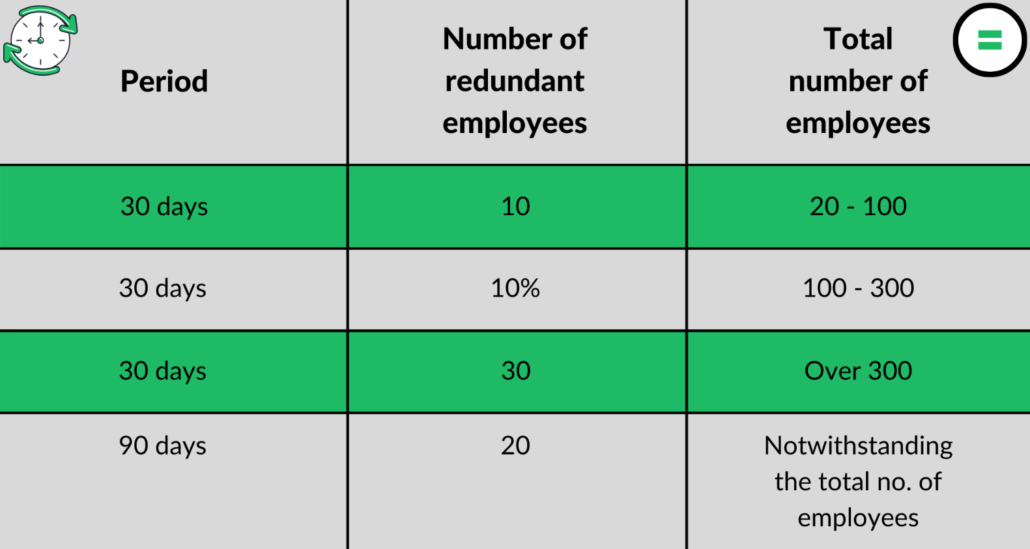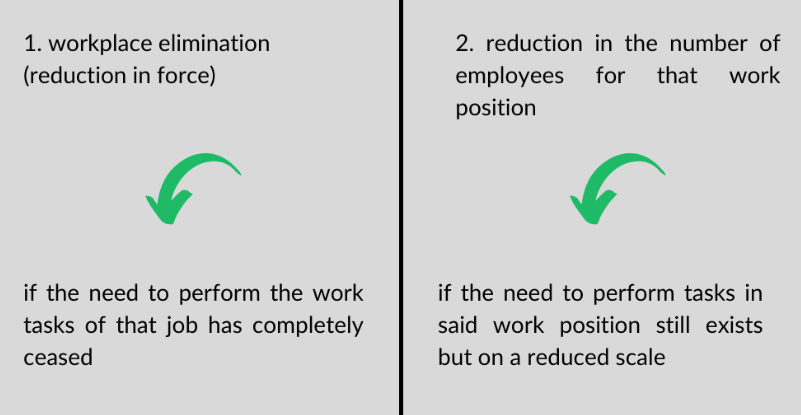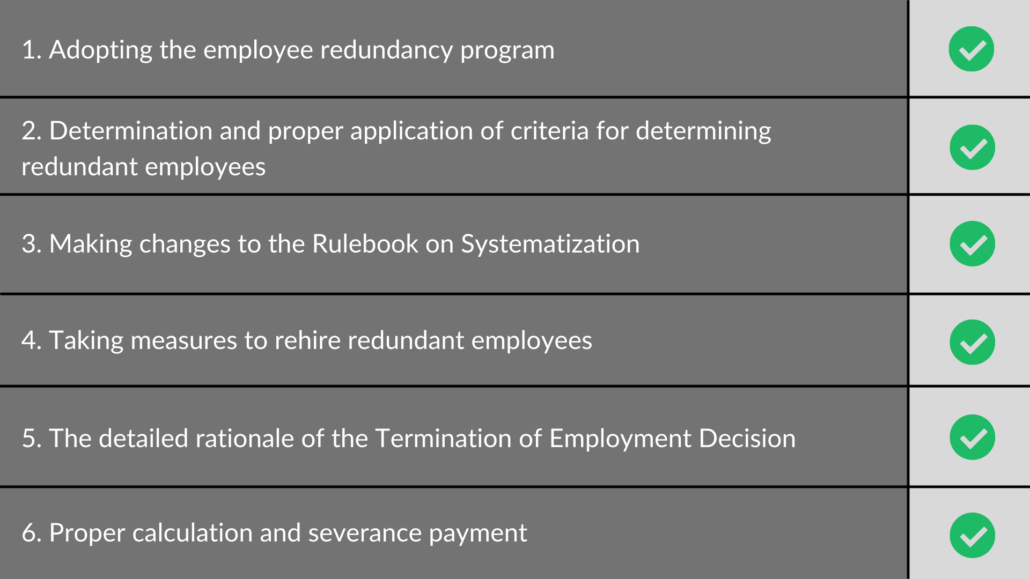Employment may be terminated in several ways in Serbia, and the termination of an employment agreement by an employer is the most frequent method found in practice.
Termination of the employment agreement for redundant employees (so-called “technological redundancy”) is provided to employers by the Labor Law, when due to technological, economic, or organizational changes the need to perform a certain job ceases, or when the employer reduces the scope of work.
This cause for termination refers solely to the needs of the employer and is independent of any employee’s (in)capabilities.
It is extremely important to carry out the redundancy procedure, as well as the entire termination procedure, following the law, because otherwise, the termination of the employment agreement may be unlawful.
1. You Have not Adopted the Employee Redundancy Program
In the process of determining redundancy, some employers must adopt a program for settling redundancies, the proposal of which is previously submitted to the National Employment Service and the trade union organization of the employer.
If you belong to the group of employers who are obliged to adopt this program, and you fail to do so, this may be the basis for a lawsuit on the part of your employees whose employment agreement was terminated due to redundancy.
The obligation to adopt an employee redundancy program exists if, due to technological, economic, or organizational changes in a certain period, you lay off a certain number of employees employed for an indefinite period, as follows:
- Within 30 days, the need for work of at least 10 employees ceases, if you have more than 20 and less than 100 employees employed for an indefinite period;
- Within 30 days, the need for work of at least 10% of employees ceases, if you have at least 100 and at most 300 employees for an indefinite period;
- Within 30 days, the need for work of at least 30 employees ceases, if you have over 300 employees for an indefinite period;
- Within 90 days, the need for work of at least 20 employees ceases, regardless of how many employees you have.

That would mean that if, for example, you have less than a hundred employees, and anticipate 8 employees to be made redundant due to organizational changes, you are not obliged to adopt the employee redundancy program.
Also, you are not obliged to adopt the employee redundancy program, even if the employee whose employment is terminated due to technological redundancy is the only employee in that position, that is, there is no reduction in the number of employees, but termination of a workplace position.
However, the fact that you do not have a legal obligation to enact a redundancy program does not mean that your decision to lay off someone as redundant may be arbitrary or unsubstantiated. In such a case, you are obliged to determine in advance by a bylaw that determines that the need for a certain number of employees has ceased, based on which it will be assessed which employees are redundant.
If you do not adopt the employee redundancy program when there is a legal obligation to do so, the decision on termination of employment in court proceedings may be deemed unlawful.
2. You Have not Certainly Properly Defined and Applied the Redundancy Selection Criteria and Properly Applied Them
When you must downsize employees in a work position due to technological, economic, or organizational changes, for instance, from five to three employees, whether the decision you make will be lawful depends on whether you have appropriately defined and applied the criteria for selecting employees for redundancy.
These criteria must be objective and clear. You are obliged to apply criteria for selecting redundant employees, even when there is no obligation to adopt a redundancy program. What is especially important to point out is that the criteria must be clearly defined in advance by your internal procedures, so that the entire procedure is transparent and legal.
If the employee initiates court proceedings against you to prove that the decision to terminate the employment is unlawful, the court would only review whether you applied the prescribed criteria, and would not enter the evaluation procedure itself, as this is an autonomous right of the employer.
The employer does not have discretion over deciding, without applying a certain criterion on which employees are redundant.
When we look at the criteria that should be applied by the employer, the highest court in Serbia declared that the quality of work could not be considered as the only criterion and that such a decision by the employer would be unlawful. The main criteria based on which it is determined which employees are redundant are the achieved work results, which is measured according to the quality of work, autonomy in work, innovation, as well as other criteria determined by the bylaws of the employer.
It is not enough for the criteria to be only defined by the employer’s bylaws, the employer must apply them and provide a clear rationale.
3. You Have not Amended the Rulebook on Internal Organization and Systematization
For the procedures of selecting redundant employees and termination due to redundancies to be carried out in accordance with the law, it is necessary to amend the Rulebook on internal organization and systematization.
By the bylaw amending the Rulebook on the organization and systematization of jobs, the employer performs:

If a work position is eliminated (option 1), it is necessary to provide proof that the need for work in that job has ceased.
If only the number of employees in a certain position is reduced (option 2), then it is necessary to provide clear and articulate reasons why a certain employee was selected for redundancy, from a pool of others who perform the same job, using the criteria listed in the previous section.
Failure to amend the Rulebook on internal organization and systematization would make the decision on termination of employment agreement unlawful, and your employee would have grounds to initiate legal proceedings against you.
It is especially important to take proper care of the working tasks that are still needed to be performed, within the workplace that is being eliminated. It is necessary to transfer these working tasks, for which there is still a need even though the workplace is eliminated, to the description of another workplace.
4. You Have Not Taken Appropriate Measures for Rehiring Redundant Employees
You are required to take appropriate measures for the rehiring of redundant employees, in cooperation with the National Employment Service and the representative union.
Appropriate measures for rehiring would be, for example, providing the employee with employment with another employer or assigning a redundant employee to another job.
If the employee refused such a measure, the termination of the employment agreement as redundancy could not be deemed unlawful. Also, if you offered the employee the conclusion of an annex to the employment agreement for another work position (because the need to work in the workplace where the employee was assigned ceased due to technological, economic, or organizational changes), and the employee refused, the termination would be lawful, of course, if all the previous steps have been followed.
Termination of the employment agreement for redundancy was also established in a situation when you cannot provide the employee with work in other positions, as well as when there are no conditions to apply other measures for rehiring redundant employees. Of course, it is necessary to be able to prove this.
On the other hand, you would make a mistake if you made an employee redundant if at the time of the termination, there was a vacancy that was adequate to the level of that employee’s qualifications, and you did not reassign the employee to that position.
An interesting fact is, that, if you were to provide the employee with employment with another employer, which would essentially resolve their employment status, you would not be obliged to pay severance.
5. You Have not Provided a Rationale for the Decision on Termination of Employment
One of the most common stumbling blocks for employers, which can cause multiple consequences, is deciding on termination of employment with a rationale that is not clear and detailed enough.
Having in mind the nature of these grounds for termination of employment, the employer is obliged to state in detail what these organizational, economic, or technological changes consist of, as well as the reasons why the need for the employee’s work has ceased. So, you need to explain why the need for the work of that employee, and not someone else, has ceased if there are several executors in the same job.
It is frequent in practice that employers terminate the employment agreement without any explanation and declare one of, for example, four employees as redundant. Not only must the decision contain an explanation, but it must not contain flat and arbitrary allegations.
If the absence of an explanation was the only omission you made in the procedure of termination of redundant employees, that would be quite enough for your (former) employee to succeed in the court proceedings against you.
6. You Didn’t Pay the Severance Payment e to the Employee
You are obliged to pay severance to the employee who has been declared redundant before the termination of the employment agreement.
Interestingly, the termination of the employment agreement will not be unlawful unless you have properly calculated and paid severance, i.e., if you have paid severance in a smaller amount than that due to the employee. In that case, the employee could initiate court proceedings against you for payment of the remaining part of the severance, but not for determining that the termination of the employment agreement is unlawful (provided that you did not make any of the above mistakes in implementing the termination procedure).
The Law prescribes the obligation of the employer to pay the severance payment before the termination of the employment agreement.
It is important to note that an employee cannot waive their right to severance. In other words, such a waiver statement of an employee’s severance entitlement would not produce a legal effect and the employee would have the right to initiate the redundancy proceedings, even if they signed a waiver statement.
As we mentioned previously, there is no obligation to pay severance to an employee if you have enabled them to be employed by another employer within the measures for new employment, thereby resolving their employment status.
Employers generally have an awareness of the obligation to pay severance to employees, so this error is not that common in practice, but it is very important to take care of it because the law stipulates both the infringement responsibility of the employer and the high fine, if it deprives the employee of the right to severance. We wrote about inspection supervision, misdemeanor procedures, and work disputes in the blog “Labor Law in Serbia – 8 most important aspects”.
7. You Increased the Number of Employees after Making Employees Redundant
When you fire an employee as a technological redundancy, you cannot hire a new employee in the same position within 3 months of the termination of the employee’s employment. If the need to perform the same jobs re-emerges, within 3 months of the termination of the employee’s employment, the employee who has been made technologically redundant has the advantage for new employment.
In practice, employers make various mistakes about this obligation.
First, some employers employ another person in the same workplace where the employee has ceased employment due to technological redundancy, and before the 3-month period of the termination of employment ends.
Also, it happens that the employer lays off the employee because it is determined that the need to work in that workplace has ceased, and in the next 3 months the number of employees in that workplace is increased by the deployment of employees from other jobs. Since it is obvious that in this situation the need to eliminate a work position, this action by the employer would make their termination of employment wrongful.
However, if you hired a specialized agency or a person within temporary employment for the work performed by an employee whose work had ceased and was fired as a technological redundancy, the termination would not be considered wrongful following certain stances of case law.
8. You Cannot Prove the Workload Is Reduced
In practice, the questionable and problematic basis for which an employer can terminate an employee’s employment agreement is if the workload has been reduced with the employer.
However, the assessment that the employer has reduced the workload cannot be given in due course or in general. In other words, an employer’s simple statement that there has been a reduction in the workload will not be enough to make the termination lawful and grounded.
The case law has taken the position that if the employer operated with a positive balance in the year when he terminated the employment agreement of the redundant employee, the decision on termination would be unlawful because there is no possibility to prove that the workload decreased.
We believe that this view is challenging and too harsh on employers because only doing business with a positive balance does not automatically mean that no workload has been reduced in any sector, and thus the need for some employees to operate has stopped. It is possible that in some sectors the workload has increased significantly, which has contributed to the balance sheet is positive, while at the same time in another sector, it has decreased, and objectively there is no need for certain employees to work.
How to Avoid Mistakes?
The practice has shown us that this ground for termination is one of the most challenging in practice, and therefore we would recommend exceptional caution in the execution.
Caution at every step in the process of determining redundant employees and terminating employment agreements is necessary, because when you get a lawsuit for determining wrongful termination, it may already be too late.
Technological Redundancy – Employer’s Obligations

If within 3 months from the day of termination of the employment of an employee deemed a technological redundancy, you cannot employ other employees in this position but must offer a job to an employee who has been deemed technological redundancy.
When you decide to go with the riskiest option, to terminate the employee’s employment agreement due to a reduction in the workload, make sure that you have proof that the workload has indeed decreased, that is, that you have not achieved a positive balance in that year, as well as that you are able to prove the decreased of the workload with another proves.
The entire procedure of terminating the employment agreement, both on this and any other grounds, must be implemented very carefully, to avoid far-reaching consequences for your company.
Adoption of appropriate internal procedures, prior understanding of the legal procedure, and all potential risks for the employer, are the cornerstone in the implementation of the proper procedure of termination of employment agreement in case of technological redundancy.

























